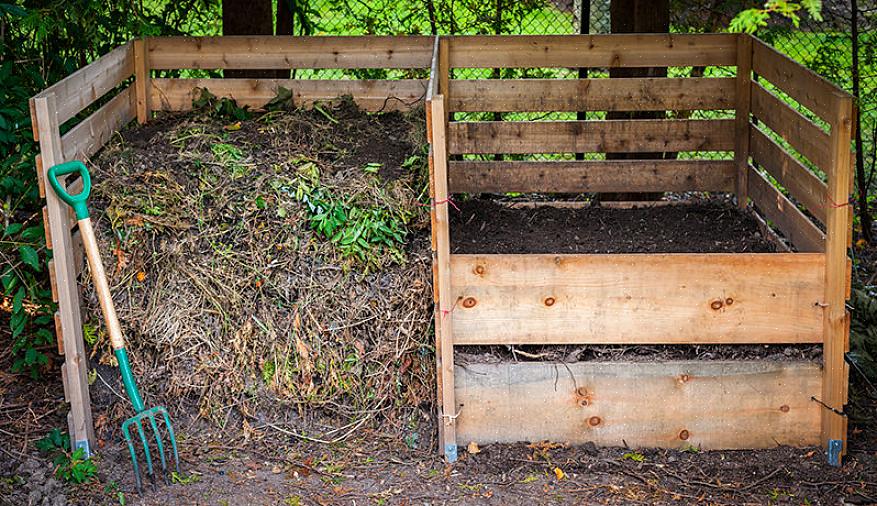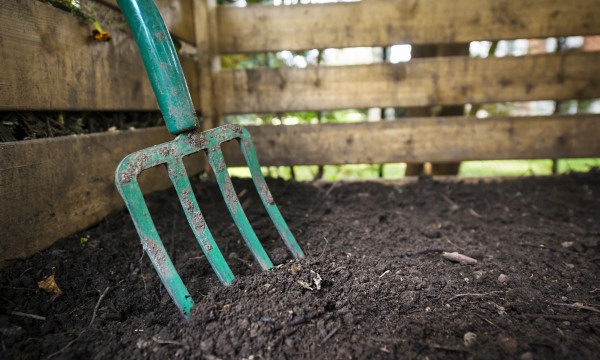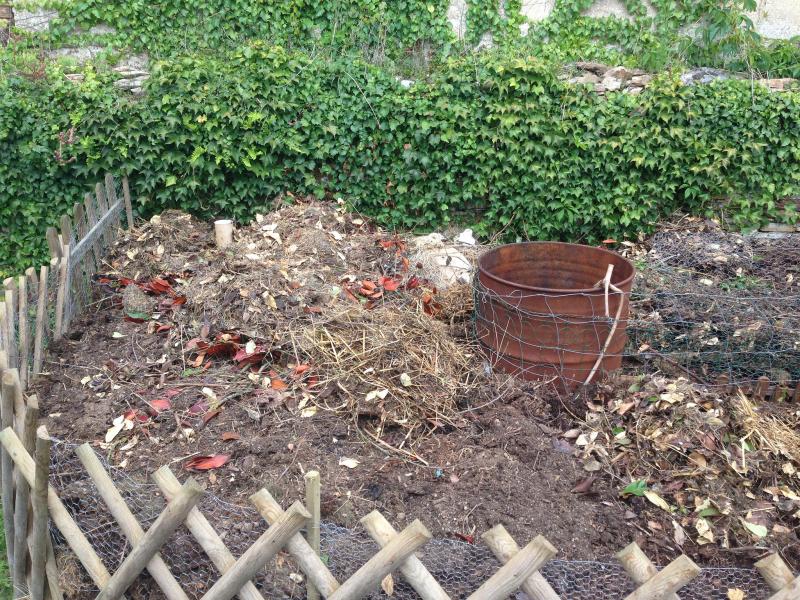Last updated on October 23rd, 2023 at 09:04 pm
Compost provides all the essential plant nutrients in an ideal composition, improves the soil and keeps plants healthy. It takes little more time to make than you would to buy fertilizer and potting soil.

With compost, the “black gold of gardeners”, you can significantly improve the productivity of your vegetable garden. Compost not only provides nutrients, it also improves the structure of the soil. We’ve put together 15 tips for you about compost.
Fruit peels are just the thing for compost.
With compost, the “black gold of gardeners”, you can significantly improve the productivity of your vegetable garden. Compost not only provides nutrients, it also improves the soil structure. We’ve put together 15 tips about compost for you.
Build a compost pile
If you want to create a compost pile, you need to choose the location carefully. The best place is under a large tree because in cool, damp shade, the waste doesn’t dry out as quickly as it would in direct sunlight. Ventilation is mostly a matter of choosing the right container: Most models have large vents in the side walls that allow carbon dioxide produced during the rotting process to escape and fresh oxygen to enter. Do not place the composter on a paved surface, even if it seems to be the “cleanest” solution. Contact with the soil is important to allow excess moisture to escape and earthworms and other “composting helpers” to enter.
Three compartments for optimal decomposition
Professionals swear by the three-chamber principle: In the first chamber, the waste is collected, in the second chamber the first phase of decomposition takes place, and in the third chamber the waste is completely decomposed. As soon as the ready compost is used, the contents of the second compartment are transferred to the third. With the waste from the first compartment, a new heap is then formed in the second. Commercially available wooden or galvanized metal composters usually have a capacity of one cubic meter. Home-made containers do not need to be any larger in order to ensure good aeration of the interior of the pile.
Principle of the 3-compartment compost heap
Flora Press/Daniela Kunze
In a three-compartment compost heap, the material can be transferred well.
Compostable waste: Diversity is important!
Lawn clippings, crop residues, leaf litter, uncooked kitchen scraps: The list of ingredients is long, and the more diverse the mixture, the more harmoniously it decomposes. Green waste is different in structure and components: Shrub pruning, for example, is airy, dry and low in nitrogen; lawn clippings, on the other hand, are very dense, moist and high in nitrogen. In order to achieve a homogeneous decomposition, the principle is to alternate thin layers of waste with the same characteristics or to mix them immediately: wet waste with dry, dense material with airy material, nitrogen-poor elements with nitrogen-rich ones.
This is not easy to put into practice because it is rare to find complementary waste at the same time in the garden. It is then possible to store after the compost of the shrubbery cut in small pieces and to mix it little by little with the lawn mowing at the right time. But can all garden waste be put into the compost? Weeds that set seeds can also be composted, as long as they are pulled before they bloom! Leave branching varieties such as quackgrass or creeping buttercup to dry on the spot after pulling, or even better, turn them into a plant purine with nettles or comfrey.
Chop shrubbery beforehand
Branches and twigs decompose even faster if they are chopped into small pieces before composting with a garden chipper. Few gardeners know, however, that the type of shredder is also decisive for how quickly the wood decomposes. So-called silent shredders, such as the Viking GE 135 L, have a slowly rotating blade. It presses the branches against a pressure plate, crushes small pieces and, unlike the classic blade chipper, also breaks up the fibres. This allows the micro-organisms living in the compost to penetrate particularly deeply into the wood and break it down quickly.
The micro-organisms in the compost also need nutrients.
Leaves, wood and shrub remains are mostly composed of carbon (C) and contain almost no nitrogen (N): experts call this a “remote C/N ratio”. But almost all bacteria and single-celled organisms need nitrogen in order to reproduce. As a result, these wastes will only decompose slowly in the compost. If you want to speed up the decomposition, you have to stimulate the activity of the micro-organisms with a compost gas pedal. It is simply spread on the waste and contains, besides guano, horn powder and other organic fertilizers, depending on the manufacturer often also algae limestone and rock powder.
Compost citrus peels
Untreated peels of lemons, oranges, tangerines or banana peels can be composted without hesitation, but because of their natural essential oils, they decompose more slowly than apple or pear peels. Fruits treated with chemical fungicides (diphenyl, orthophenylphenol and thiabendazole) can disrupt the activity of compost microorganisms, especially the red compost worm, which flees. But in small enough quantities, they are safe and do not leave detectable residues.
Organic compost

Fruit peels are just right for compost.
Wild herbs harmonize the decomposition process
In bio-dynamic cultivation, specially developed extracts from yarrow, chamomile, nettle, oak bark, dandelion and valerian are added to freshly deposited material. These herbs, in small quantities alone, harmonize the decomposition process and also indirectly strengthen the humus composition of the soil as well as the growth and resistance of the plants. In the past, the addition of nitrogenous lime was often recommended to decimate germinating weed seeds or pathogens and to increase the nitrogen content. Organic gardeners forego the use of this supplement, which is harmful to microorganisms, and enhance the fertilizing effect by adding cow manure or moistening the compost with nettle manure.
Bentonite to improve soil structure
Bentonite is a mixture of different clay minerals. It is applied to light sandy soils to improve their ability to store water and nutrients such as calcium and magnesium. The effect of bentonite is even more intense if it is regularly applied to compost. The clay minerals bind with humus particles to form what are called clay-humus complexes. These give the soil a favorable lumpy structure, improve its water retention capacity and act against the leaching of certain nutrients. In short: With this “special compost”, sandy soils become much more fertile than with traditional humus.
Active contributors: fungi, bugs and so on
Did you know that a handful of compost contains more micro-organisms than there are people on earth? During the initial and transformation phase, the temperature of the compost heap increases from 35 to 70 °C. It is mainly fungi and bacteria that come into play. Sowbugs, mites, agricultural beetles, red compost worms and other tiny insects only enter the initial phase when the pile has cooled down (8th to 12th week). In the maturing compost, beetle larvae and the beneficial larvae of the golden beetle (recognizable by their large hindquarters) are found, and wild grasses such as chickweed germinate on the heap or on its edges. The earthworms only arrive in the last phase of maturation when the compost has gradually turned into soil.
Covering the compost

A cover with reed mats or a breathable veil prevents the compost from drying out in the sun and getting soaked by rain.
Protection against wind and weather
Open compost bins must be covered to prevent the pile from drying out on top, cooling down too much in the winter, or getting soggy from rain or snow. Straw or reed mats are suitable, as well as thick breathable compost fleece, which can also be used to cover the entire compost pile in case of frost. You should only cover the compost with plastic film for a short time, for example during particularly heavy rainfall, to prevent too many nutrients from being washed away. Major disadvantage: Plastic films do not allow air to pass through. The waste underneath does not receive any oxygen and starts to rot. On the other hand, the compost should not be allowed to dry out completely because microorganisms prefer a moist and warm environment.
How to recognize mature compost
Depending on the season, it takes six to twelve months for the coarse plant remains to turn into a dark humus. Mature compost has a pleasant woodland smell. Apart from eggshells and a few small pieces of wood, there should be no more coarse material to be detected. By moving and turning the compost several times, the process can be accelerated. The decomposition can then be slightly corrected. If the material is too dry, fresh plant waste can be added or each newly deposited layer can be moistened with a watering can. If the pile is rotting or has a musty smell, chopped up shrub trimmings, leaves or twigs will lighten and aerate the soggy material. The stage of decomposition can be checked with a simple “watercress test”.

Sieve the compost before spreading it
When you prepare your vegetable beds or seedling bed in the spring, you must first sift the compost you need: it will then be easier to form regular seedling lines. The best way to sift is to use a compost sieve with a not too tight mesh (at least 15 millimeters) that you can make yourself and throw the compost into it with a fork. The coarse material will slide down the surface at an angle and will be mixed again when a new compost pile is formed.
Bringing in compost: when and how much?
The best time to use mature compost is when preparing the beds in spring. You can also spread it around all the plants in the garden during the growing season and scratch the surface. Nutrient-intensive vegetables such as cabbage, tomatoes, zucchini, celery and potatoes will receive four to six liters of compost per square meter of bed each year. Vegetables with medium needs such as kohlrabi, onions and spinach will need two to four liters. This amount will also be sufficient for fruit bushes and flower and perennial beds. Low volume vegetables such as peas, beans and herbs, as well as grass, will only need one to two liters. As a general rule, clay soils need slightly less compost than sandy soils. In the vegetable garden, compost should be applied in the spring after the soil has been lightened and raked to the surface. Permanent crops such as fruit trees or berry bushes can also be mulched with compost in the fall.
What to do with diseased plants?
Scientific studies have shown that plants whose leaves are attacked by fungal diseases such as mildew, rust or brown rot can be composted. Tests with compost extracts even suggest that antibiotics are formed during the composting of infested material, which have a positive effect on the plants. The prerequisite for this is a good decomposition process with initial temperatures above 50 degrees Celsius. Pathogens of root diseases in the soil, such as cabbage looper, survive even in the compost: it is better to dispose of infested plants in other ways!

Making liquid fertilizer from compost
Compost juice is a natural and economical liquid fertilizer that works quickly. To make it, put a scoop of compost in a bucket of water, mix vigorously and spread with a watering can without diluting after decanting. To obtain a plant-strengthening compost decoction, let the mixture stand for two weeks, stirring it well every day. Then filter the extract through a cloth, dilute it (1 part decoction to 10 parts water) and spray it over the plants.


